June 10th, 2010

Brint Smith
[Today I’d like to introduce my readers to a new contributor to the Bridging blog: Brint Smith, Executive Vice President of Brookwood Group, based in our Atlanta office. Brint has been my colleague for over 30 years, both as an experienced architect and program manager, and is one of the most experienced practitioners of the Bridging method of project delivery. I hope that you will find Brint’s contributions as insightful as I so often do. – George Heery, June 10, 2010]
I was recently reading an article in ENR, June 7th edition, entitled “Firms providing alternative project delivery find new markets to cushion the overall downturn”. The article mentions both Design-Build and Construction Manager at Risk as the two alternative delivery methods. In the article, it notes that more and more state legislatures are lifting legal roadblocks to public use of design-build which is opening up new markets for the delivery system. State agencies are recognizing that they had to Read the rest of this entry »
Tags: Construction, contractor, delivery, downturn, ENR, fixed, method, price
Posted in Industry | 1 Comment »
May 21st, 2010

In using Bridging or any other project delivery method I have always contended that program managers and architects should focus first on the Owner’s posture for purchasing construction. In my view, virtually all construction Owners fall into one of two different categories:
- Owners who may prudently rely upon relationships in the procurement of construction.
- Owners who may not or should not rely upon relationships for the procurement of construction.
The smart way of going about the procurement of construction for these two different types of Owners is as different from one another as day is from night.
Owners who may be able to rely upon relationships in the procurement of construction would be owners such as major real estate developers (in normal economic times) who are constantly in the market for Read the rest of this entry »
Tags: Bridging 101, Construction, owner, posture, procurement, relationship
Posted in Bridging 101 | No Comments »
May 10th, 2010
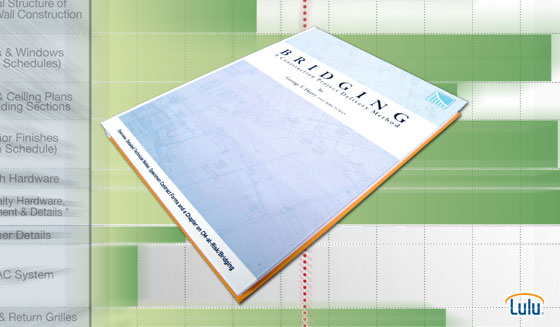
Back in 1974, I wrote my first book “Time, Cost & Architecture” (McGraw-Hill 1975) in which I described a way to achieve more effective time/cost control through better design and construction management methods.
Several days ago my colleague Ennis Parker sent out a message informing people about the publication of my second book “Bridging: A Construction Project Delivery Method” (available from Lulu.com), which some have stated to be the logical “evolution” of the concepts I set forth in my first book.
In the days following Ennis’ announcement we have received a considerable amount of interest in both the new book and this blog, and one of the more amusing responses was “What took George so long?” – a great question!
In retrospect, I realize that I’ve been writing this book for nearly twenty years; a great deal of the text inside the new book Read the rest of this entry »
Tags: book, Bridging 101, Lulu, mistakes, problems, publish, published
Posted in General | 1 Comment »
February 18th, 2010
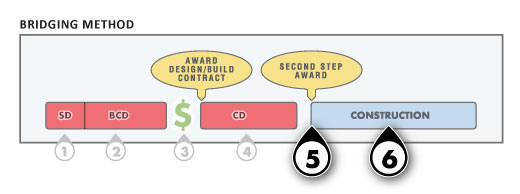
CONCLUDING WITH THE 5TH AND 6TH PHASES OF CARRYING OUT A PROJECT BY THE BRIDGING METHOD.
Phase 5. At this point the Owner has the right to terminate the contract without cause by payment of the amount due to the contractor for completion of the CD’s. If the Owner chooses to proceed, the Contractor authorizes construction. Note that (after the proposal has been submitted by the Contractor in Phase 3) the Contractor has no opportunity to adjust the price unless the Owner has approved in writing with a Change Order.
Phase 6. Throughout the construction, the ODC, along with the Owner’s program manager and any other CA specialists the Owner has employed, will observe the work in detail in exactly the same Read the rest of this entry »
Tags: conflict, drawings, grace, interest, period, phase
Posted in Bridging 101 | No Comments »
February 11th, 2010
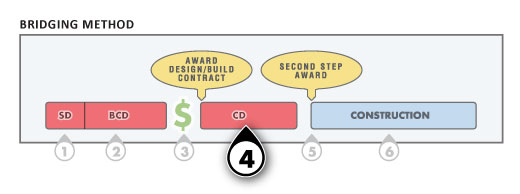
Phase 4. During the preparation of the Construction Documents (“CD”) phase the Contractor’s AE completes all detailed engineering design and specifications. Any remaining details of the architectural and site development design are completed in accordance with all applicable codes and fully coordinated these documents. The ODC reviews these documents for full and complete compliance with the BCDs and may reject them if Read the rest of this entry »
Tags: BIM, code, Construction, contractor, documents, phase
Posted in Bridging 101 | No Comments »
February 2nd, 2010
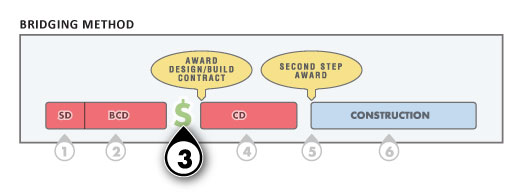
PHASE 3 : THE RECEIPT OF BIDS FOR OR NEGOTIATION OF THE DESIGN-BUILD FORM OF CONTRACT
Phase 3. With the BCDs as the “bidding” documents (see Article 4), the Owner can obtain competitive bids or negotiate with a single selected Contractor for a design-build form of construction contract. This contract price is fully enforceable, with no opportunity for future adjustment in price or schedule unless Read the rest of this entry »
Tags: bidding, bids, Construction, documents, negotiation, phase, receipt
Posted in Bridging 101 | No Comments »
January 28th, 2010
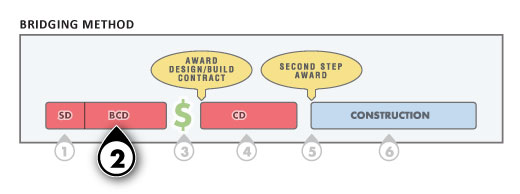
PHASE 2 OF CARRYING OUT A PROJECT BY THE BRIDGING METHOD IS CRITICALLY IMPORTANT AND SETS THE METHOD APART FROM OTHER METHODS
Phase 2. Design work and specifying done in this phase are referred to as the preparation of the Bridging Contract Documents (BCDs) and involve the ODC developing all important and critical aspects of the architectural design including at least the controlling details of the design. This design work and document preparation for a Bridging project is carried out at the same point in the sequence of design as the Design Development phase of services in the traditional Design-Bid-Build with about the same or somewhat greater overall level effort as in the production of typical Design Development (“DD”) documents. However, the Bridging Contract Documents (BCDs) are substantially different from DD documents. Use of typical DD documents at this point will probably cause Read the rest of this entry »
Tags: contract, design elements, documents, phase
Posted in Bridging 101 | No Comments »
January 26th, 2010
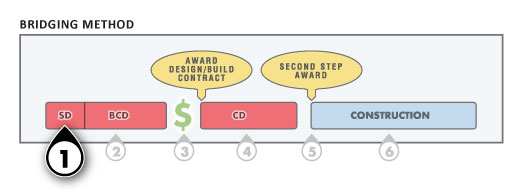
FIRST DESIGN PHASE IN THE BRIDGING METHOD OF CONSTRUCTION PROJECT DELIVERY
Phase 1. The design work and documents prepared in this phase are the same in every respect in both the traditional Design-Bid-Build and the Bridging methods. Prior to this phase, in both methods, the Owner will have selected the design architect, whether an individual, a team, or a firm. The design architect team or firm will include consulting engineers for at least mechanical, electrical, plumbing and structural (“MEPS”) engineering disciplines. In the traditional Design-Bid-Build method this team is referred to as “the Architect’. In Bridging, this team is referred to as the Owner’s Design Consultant (“ODC”) including the ODC’s engineering consultants. The ODC nomenclature is used in Bridging to make clear that Read the rest of this entry »
Tags: BIM, bridging architect, design architect, ODC, phase, schematic
Posted in Bridging 101 | No Comments »
January 15th, 2010
I’ve been asked if I can boil the Bridging method down into a short narrative description.
Basically, Bridging is a hybrid of the traditional Design-Bid-Build method and the Design-Build method that retains the best features of both in terms of the Owner’s best interests and eliminates the aspects of those two delivery methods that often cause problems for the Owner.
In Bridging, the Owner engages a design firm, usually an architectural firm for most building projects. This entity is referred to as the Owner’s Design Consultant (“ODC”). The ODC prepares a set of bid documents (or negotiation documents) that, in its preparation, require about the same level of Read the rest of this entry »
Tags: description, diagram, explanation, synopsis
Posted in Bridging 101 | No Comments »
January 4th, 2010
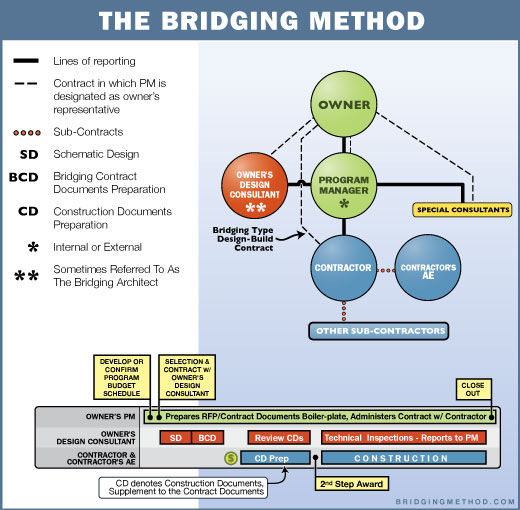
Before we get into the nuts and bolts of the Bridging method we should understand the arrangements between all the parties in a Bridging program. Consulting the diagram above, any well run project of any size will have either an internal or external contract Program Manager who is technically and managerially competent, and to whom all parties Read the rest of this entry »
Tags: chart, Contracts, contractual, diagram, organization, orgchart, reporting, schedule
Posted in Bridging 101 | No Comments »
January 1st, 2010

Hello, I’m George Heery and I’d like to welcome you to The Bridging Method Blog; an online resource for the Bridging method of construction project delivery. The intent of this site is to foster discussion among owners and industry professionals about the Bridging method and the details that make Bridging work well for project owners.
Bridging was originally developed for project owners who cannot or should not rely upon relationships in the procurement of construction. This includes virtually all public sector owners and many private sector owners. However, since the development of Bridging a number of owners who might well be able to rely upon relationships in the procurement of construction, but are of a “belt and suspenders” mentality Read the rest of this entry »
Tags: george heery, guide, project delivery, welcome
Posted in Bridging 101 | 1 Comment »









